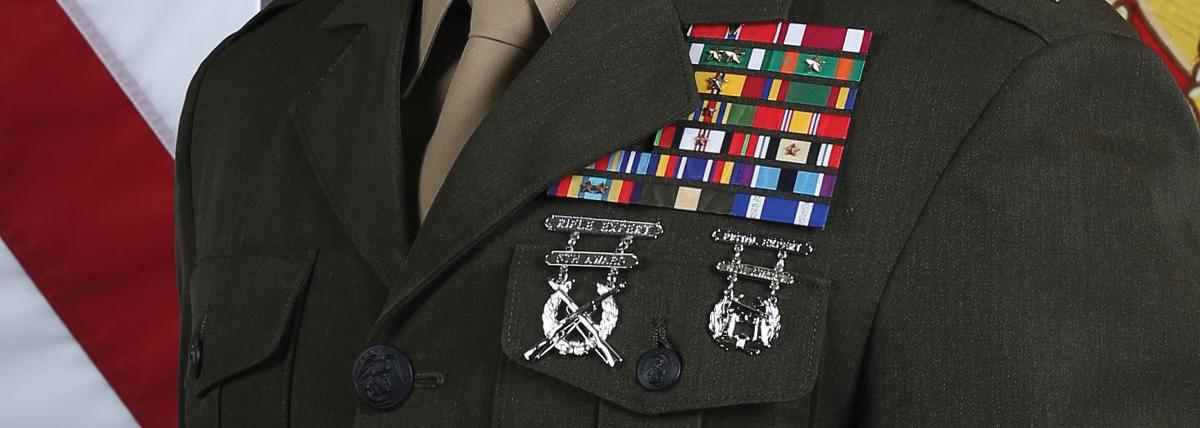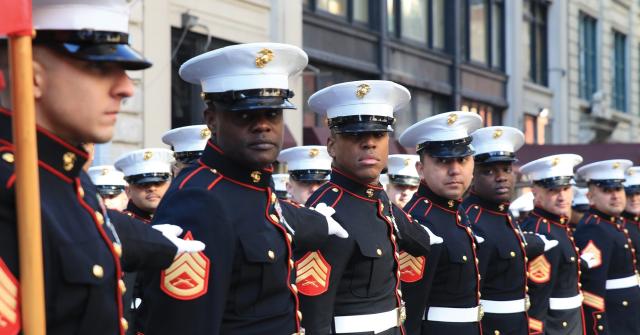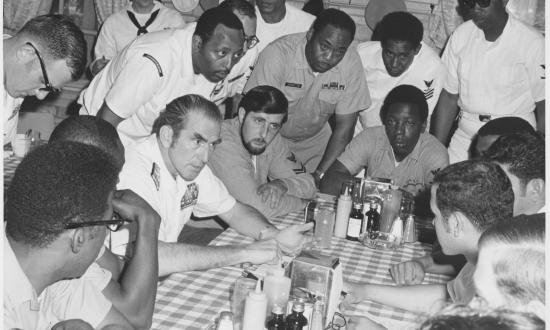The Department of Defense (DoD) strives to have a workforce that reflects the nation’s demographics. Historically, it has failed to achieve this level of diversity within its senior leaders and officer ranks. On 1 January 2021, the Departments of Defense and Homeland Security secretaries, military service secretaries, and Commandants of the Marine Corps and Coast Guard were all caucasian and, with the exception of the Secretary of the Air Force, male.
While the confirmation of General Lloyd Austin as Secretary of Defense marks another “first,” the disparity in representation is still undeniable. Of the 1.3 million active-duty men and women in the U.S. military, 43 percent identify as people of color. But the people at the top of the chain of command, making crucial life-and-death decisions on their behalf, are almost exclusively white and male.1
As part of their efforts to cure this deficiency, the services have enacted various policies aimed at eliminating actual and perceived bias. One such policy is the removal of photographs and other identifying indicators from the promotion board process. This “color-blind” approach is designed to “sterilize the packages” and remove any conscious or unconscious bias.2 However, psychological and social science research suggests that these types of color-blind diversity and inclusion efforts may not be effective. Whether it is a personal mantra of “I don’t see skin color” or removing photographs from promotion boards, ignoring the complexities of race does not make them disappear.3
Removing photographs from the promotion board process will not solve the issue of bias in the Sea Services. The Department of the Navy (DoN) should be innovative and lead the other services in developing an inclusive approach that recognizes the individual characteristics of each naval officer. Although color-blindness is a widely embraced principle of diversity, masking group differences can create a culture of ignoring real group disparities—covering up problems instead of addressing them.4
Through the Years
Color-blindness is “the belief that racial and ethnic differences should not be taken into account when decisions are made, impressions formed, and behaviors enacted; if people or institutions do not even notice race, they cannot act in a racially biased manner.”5 This modern take on the concept of being color-blind, however, ignores the origins of the term and the inherent defects in the philosophy.
The term “color-blind” can be traced back to 1896, when Supreme Court Justice Marshall Harlan used the term in his dissent to the majority ruling in Plessy v. Ferguson, a case in which the court ruled that state-mandated segregation laws did not violate the equal protection clause of the 14th Amendment:
The white race deems itself to be the dominant race in this country. And so it is, in prestige, in achievement, in education, in wealth, and in power. So, I doubt not, it will continue to be for all time, if it remains true to its great heritage and holds fast to the principles of constitutional liberty. But in the view of the Constitution, in the eye of the law, there is in this country no superior, dominant, ruling class of citizens. . . . Our Constitution is color-blind and neither knows nor tolerates classes among citizens.6
In the 1960s, color-blind became the new buzzword. During the civil rights movement, political pundits sought ways to make their rhetoric more appealing while still serving their own personal interests; “color-blind” was the solution.7 Believing that color-blindness should be an American ideal, James Kilpatrick, an activist journalist, advocated that individuals should be judged based on their merits and qualifications. However, Kilpatrick and other public personalities failed to consider that because of slavery, Reconstruction, and Jim Crow laws, people of color had significantly lower qualifications than their white counterparts.
In 2007, the notion that a color-blind approach would be a cure-all for discrimination and bias made a reappearance in a Supreme Court opinion. Deciding on a case involving a local school district’s effort to achieve diversity, U.S. Supreme Court Chief Justice John Roberts, advocating for the removal of race as a basis for decision-makers to enact policies, wrote: “The way to stop discrimination on the basis of race is to stop discriminating on the basis of race.”8
A review of U.S. military history provides some explanation for the lack of color at the higher echelons of authority and power today. In 1925, guidance for Army officers stated that black service members were a class “from which we cannot expect to draw leadership material.”9 In addition, it is important to remember that the services were not fully integrated until after World War II, and consequently, the multigenerational legacy of military service is not a familial hallmark for officers of color. Indeed, for women, ethnic minorities, and other underrepresented groups, history does not tell an inspiring story of how earlier generations treated non-caucasian men in the services. Even today, while the service academies continue to strive for diversity, class populations continue to lack proportional amounts of pigmentation. The cadets and midshipmen of color who are admitted are often steered toward logistics and transportation rather than combat arms and warfare specialties—traditionally, the latter leading to higher levels of command and authority.10
The Sea Services—and the entire Department of Defense—spent decades discriminating against women, ethnic minorities, and members of the LGBTQ+ community, creating a culture of discrimination masked behind the veil of meritocracy. It was only a few short years ago that the first African American woman was anointed with a star in the Marine Corps. In its nearly 245 years of existence, the Marine Corps has never had a four-star general who was not caucasian and male. The résumés and credentials of retired Major General Charles Bolden Jr., who broke barriers on land, in the air, and in space, as well as retired Lieutenant General Ronald Bailey, who was the first African American to command the First Marine Division, beg the question as to how neither was able to reach higher echelons of command.
True color-blindness is not possible. Plainly put, people notice race when they observe each other. Perceptual differentiation of race occurs rapidly—in less than one-seventh of a second—and emerges as early as six months of age.11 It would be impractical and illogical for any organization to strive to achieve racial blindness. It simply is not possible.
Worth A Thousand Words
“I am a woman.”
“I am black.”
“I am queer.”
These statements are not the reasons why a service member is or is not qualified for promotion, but they are a part of who that service member is. To ignore, deny, or sterilize those features is to be willfully blind to major components of these service members’ identities. During a virtual town hall on 24 September 2020, when asked about reconsidering the move to take photographs out of promotion board packages, Chairman of the Joint Chiefs of Staff General Mark Milley responded:
All the service secretaries think this is the way to go, they made recommendations to the Secretary of Defense and those actions are being implemented as we speak, and I fully support them. I think it’s a good way to go and I think the results will be telling in the future.1
The Chairman’s response is not surprising. Extensive psychological and social research has found that caucasians favor color-blindness more than people of color—those who grew up in the 1980s and 1990s were explicitly taught that color-blindness was a positive goal.13 Why? Color-blindness allows those who are often associated (rightfully or wrongfully) with perpetrating racism to maintain a belief that they are not biased or prejudiced.14
While military leaders may feel better about their decision to remove photographs from the promotion process, whether their efforts will be effective is debatable. The full impact of the Chairman’s intent to “sterilize the board files without any identifying characteristics” will not be limited to ethnic minorities.15 Assuming that names, genders, marital status, and age also are removed from the packages, anyone who identifies as a member of an underrepresented minority group will be affected as well. Although the intent to fairly evaluate promotability is admirable, this approach fails to address the underlying issues that have led to the current status quo. The relationship between the officer and reporting senior, the climate in which the officer operates, and the historical systemic challenges that affected minority promotions will not be cured by sterilized promotion packages.
The problem is not that color and other characteristics are seen; the problem is that they are not appreciated or valued. Conversely, the solution is not erasing everything that makes people different, but respecting and appreciating the value of those differences. For the Sea Services, a response that does not include addressing the historic and institutionalized culture of discrimination will not result in achieving the desired outcome of equity and inclusion; it will only build on a flawed foundation. In addition, a response that ignores the current disparity in gender identification and ethnicity will only breed more of the status quo.
Kodak Moments
In contrast to color-blindness, multiculturalism is the idea that differences should be recognized, appreciated, and celebrated (not sterilized). One of America’s earliest mantra’s, E Pluribus Unum, celebrates the diversity of the republic and does not attempt to turn a blind eye toward it. Former President Barack Obama spoke to this diversity in his 2009 inaugural address, saying, “For we know that our patchwork heritage is a strength, not a weakness. We are shaped by every language and culture, drawn from every end of this earth.”
Researchers report, “When people are encouraged to use a multicultural approach, they are better at understanding the perspectives of other people and better at spotting discrimination when it occurs.”16 By adopting an approach that celebrates the diversity of everyone, including caucasian men, the service can avoid homogenizing the force. Indeed, race, gender, sexuality, and other distinguishing characteristics are not just hot topics or political talking points—they are characteristics of the naval force. Open conversation and deliberate action to correct the flawed policies of the past will be necessary to achieve a fully diverse and inclusive force for the future. The service was deliberate and unabashed when it enacted and enforced discriminatory policies; therefore, reason dictates it must be equally bold in their correction.
As an alternative and compromise, the DoN should allow naval officers the opportunity to include a standardized biographical data form in their official promotion packages. Members would have the option to complete the form in full, partially, or not at all. Similar to voluntary statements, letters of reference, or other addendum statements, the inclusion of biographical information, or lack thereof, would not be held against the member. On the contrary, it would be a mechanism for the officer to provide greater insight to who they are as a complete individual. This option would provide all members (including those who identify as men and/or caucasian) the opportunity to include information for consideration, if they believe it would be in the best interest of their package—leaving it to the officers to decide what information best completes the picture of who they are as naval leaders.
Meritocracy is a noble approach to recognize and reward hard work and achievement. However, the Achilles heel to a system of merit is that everyone within that system must be afforded the same opportunities and tools to achieve success. Understanding that decades of deliberate action have been taken to tilt the scales in one direction, equitable counteraction must be taken to balance them out. This is not to suggest that counteraction is promoting unqualified people, but the service has an obligation to look at itself, eyes open, with 20/20 vision, and be cognizant of its appearance and composition.
Taking a cue from Chief Justice Roberts, the best way for the naval service to not be a homogeneous institution is to stop being a homogeneous institution.
1. Helene Cooper, “African-Americans Are Highly Visible in the Military, But Almost Invisible at the Top,” The New York Times, 25 May 2020.
2. Transcript from 24 September 2020 Global Virtual Townhall.
3. Evan Apfelbaum, Michael Norton, and Samuel Sommers, “Racial Color Blindness: Emergence, Practice, and Implications,” Current Directions in Psychological Science 21, no. 3 (June 2012): 205–9.
4. “Approaches to Diversity: Colorblindness vs. Multiculturalism,” Social Psych Online, 30 May 2017.
5. Apfelbaum, Norton, and Sommers, “Racial Color Blindness.”
6. Plessy v. Ferguson, 163 U.S. 537 (1896).
7. Project READY: Reimagining Equity & Access for Diverse Youth, “Module 11: Confronting Colorblindness and Neutrality.”
8. Parents Involved in Community Schools v. Seattle School District No. 1, 441 U.S. 201 (2007).
9. Cooper, “African-Americans Are Highly Visible in the Military, But Almost Invisible at the Top.”
10. Cooper.
11. Yari Bar-Haim, Talee Ziv, Dominique Lamy, and Richard M. Hodes, “Nature and Nurture in Own-Race Face Processing,” Psychological Science 17, no. 2 (February 2006): 159–63.
12. Transcript from 24 September 2020 Global Virtual Townhall.
13. Project READY, “Module 11: Confronting Colorblindness and Neutrality.”
14. Helen A. Neville, Roderick L. Lilly, Georgia Duran, Richard M. Lee, and LaVonne Browne, “Construction and Initial Validation of the Color-Blind Racial Attitudes Scale,” Journal of Counseling Psychology 47, no. 1 (January 2000): 59–70; Carey S. Ryan, Jennifer S. Hunt, Joshua A. Weible, Charles R. Peterson, and Juan Casa, “Multicultural and Colorblind Ideology, Stereotypes, and Ethnocentrism among Black and White Americans,” Group Processes & Intergroup Relations 10, no. 4 (October 2007): 617–37.
15. Transcript from 24 September 2020 Global Virtual Townhall.
16. Evan Apfelbaum, “Color Blind Policies Could Make Diversity Harder to Achieve,” Association for Psychological Science, 19 June 2012.









